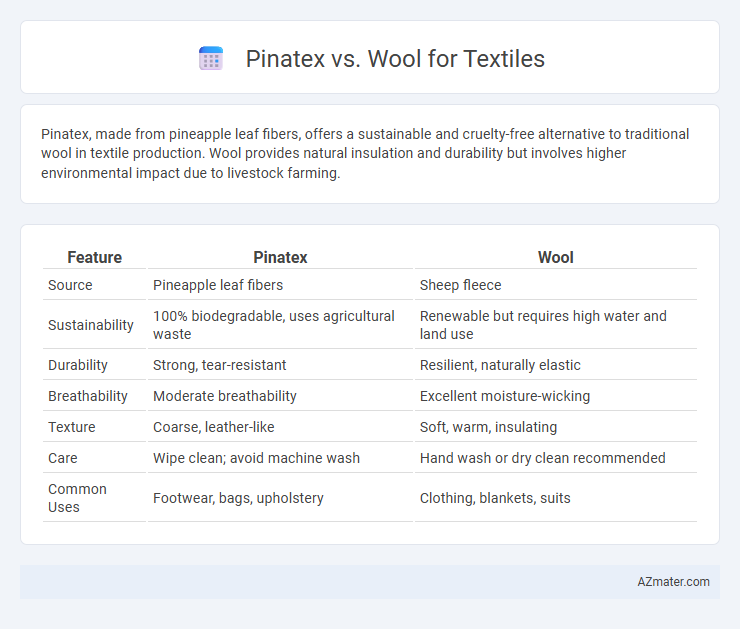Pinatex, made from pineapple leaf fibers, offers a sustainable and cruelty-free alternative to traditional wool in textile production. Wool provides natural insulation and durability but involves higher environmental impact due to livestock farming.
Table of Comparison
| Feature | Pinatex | Wool |
|---|---|---|
| Source | Pineapple leaf fibers | Sheep fleece |
| Sustainability | 100% biodegradable, uses agricultural waste | Renewable but requires high water and land use |
| Durability | Strong, tear-resistant | Resilient, naturally elastic |
| Breathability | Moderate breathability | Excellent moisture-wicking |
| Texture | Coarse, leather-like | Soft, warm, insulating |
| Care | Wipe clean; avoid machine wash | Hand wash or dry clean recommended |
| Common Uses | Footwear, bags, upholstery | Clothing, blankets, suits |
Introduction to Piñatex and Wool
Pinatex, a sustainable alternative made from pineapple leaf fibers, offers a biodegradable and eco-friendly textile option that reduces agricultural waste. Wool, a natural fiber harvested from sheep, is valued for its insulation, durability, and moisture-wicking properties in textiles. Both materials serve as renewable resources, yet Pinatex emphasizes plant-based sustainability while wool represents animal-derived comfort and performance.
Origin and Production Processes
Pinatex is a sustainable textile made from pineapple leaf fibers, a byproduct of pineapple farming primarily sourced from the Philippines and other tropical countries, while wool originates from the fleece of sheep, predominantly raised in countries like Australia, New Zealand, and the UK. Pinatex production involves extracting fibers from discarded pineapple leaves, which are then processed and formed into non-woven textiles using eco-friendly methods that reduce water and chemical use. Wool production includes sheep shearing, cleaning, carding, and spinning, requiring significant water and energy consumption, with environmental impacts tied to livestock farming such as methane emissions and land use.
Environmental Impact Comparison
Pinatex, derived from pineapple leaf fibers, offers a sustainable alternative to traditional wool by utilizing agricultural waste and reducing deforestation risks associated with livestock farming. Wool production generates high greenhouse gas emissions, consumes significant water resources, and causes land degradation, whereas Pinatex's renewable source lowers carbon footprint and conserves water. The biodegradability of both materials varies; wool naturally decomposes faster, but Pinatex's plant-based fibers contribute to circular economy goals through innovative recycling pathways.
Durability and Longevity
Pinatex, made from pineapple leaf fibers, offers remarkable tensile strength and resistance to wear, making it highly durable for everyday use, though it may show signs of aging faster in harsh outdoor conditions compared to wool. Wool, a natural protein fiber, boasts exceptional elasticity, moisture-wicking properties, and resistance to pilling, contributing to its long-lasting performance in both garments and upholstery. While Pinatex excels in sustainable innovation, wool's inherent resilience and ability to maintain structure over time make it a preferred choice for longevity in textiles.
Texture and Aesthetic Qualities
Pinatex offers a unique, fibrous texture derived from pineapple leaf fibers, presenting a natural, sustainable alternative with a slightly coarse but flexible feel, ideal for eco-conscious fashion. Wool provides a dense, soft texture with excellent warmth and elasticity, known for its luxurious appearance and ability to retain shape in high-end garments. While Pinatex emphasizes rustic and organic aesthetics suitable for casual and avant-garde designs, wool excels in classic, refined styles with a smooth and plush finish.
Comfort and Wearability
Pinatex, made from pineapple leaf fibers, offers a lightweight and breathable textile ideal for warm climates but may lack the softness and flexibility of wool. Wool provides superior insulation, moisture-wicking properties, and natural elasticity, making it highly comfortable and durable for a wide range of temperatures. Both materials excel in sustainability, yet wool's ability to adapt to different weather conditions often enhances long-term wearability compared to the more rigid texture of Pinatex.
Versatility in Fashion and Design
Pinatex, derived from pineapple leaf fibers, offers a sustainable and cruelty-free alternative with a texture resembling leather, making it highly versatile for avant-garde fashion and innovative accessories. Wool, a natural protein fiber from sheep, provides exceptional warmth, breathability, and elasticity, ideal for classic garments and high-performance outdoor wear. Both materials enable diverse design applications but cater to different aesthetic and functional needs within the fashion industry.
Cost and Market Availability
Pinatex offers a cost-effective alternative to wool, with prices typically ranging from $20 to $40 per square meter, making it more accessible for sustainable fashion brands aiming to reduce expenses. Wool, especially high-quality or specialty varieties, can cost between $50 and $100 per square meter, reflecting its natural durability and insulation properties but limiting affordability for mass-market textile applications. Pinatex's market availability is expanding rapidly due to increasing demand for plant-based, cruelty-free materials, whereas wool maintains a strong traditional market presence, especially in colder climates and luxury apparel sectors.
Vegan and Ethical Considerations
Pinatex, derived from pineapple leaf fibers, offers an innovative vegan alternative to traditional wool in textiles, eliminating animal cruelty and reducing environmental impact. Wool production often involves ethical concerns such as animal welfare issues and intensive land use, whereas Pinatex supports sustainable agriculture by utilizing agricultural waste. Choosing Pinatex aligns with eco-conscious fashion trends, promoting cruelty-free materials and resource-efficient practices within the textile industry.
Future Trends in Sustainable Textiles
Pinatex, a sustainable leather alternative made from pineapple leaf fibers, is gaining traction in the textile industry due to its low environmental impact and biodegradability compared to traditional wool. Wool production, while renewable, faces challenges such as high water usage and methane emissions, prompting a shift towards plant-based materials like Pinatex for future sustainable textiles. Innovations in bio-fabrication and circular economy practices emphasize Pinatex's potential to outperform wool in eco-friendly fashion, aligning with global trends towards carbon-neutral and animal-free products.

Infographic: Piñatex vs Wool for Textile
 azmater.com
azmater.com